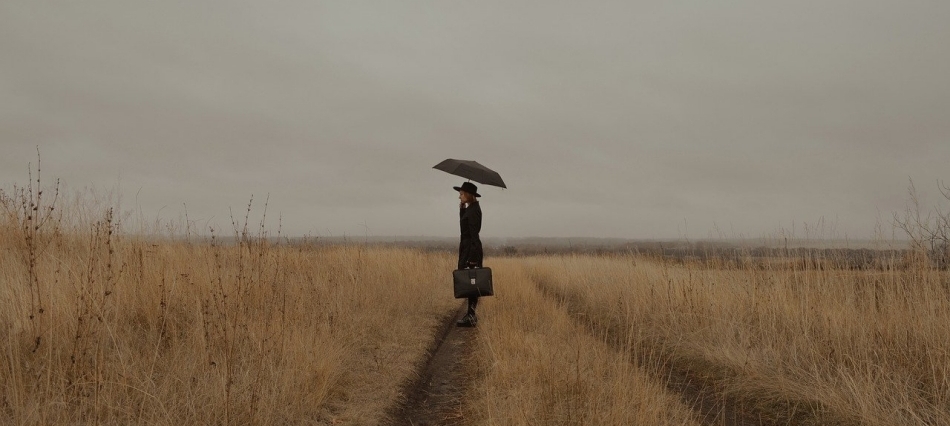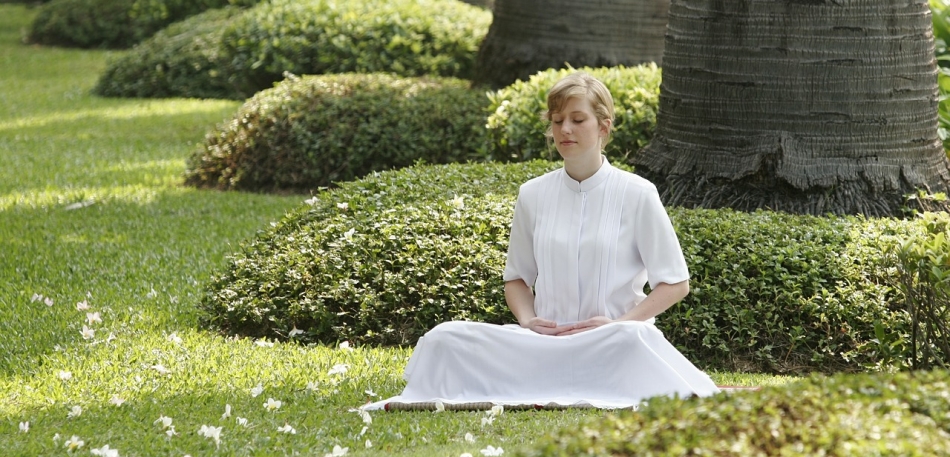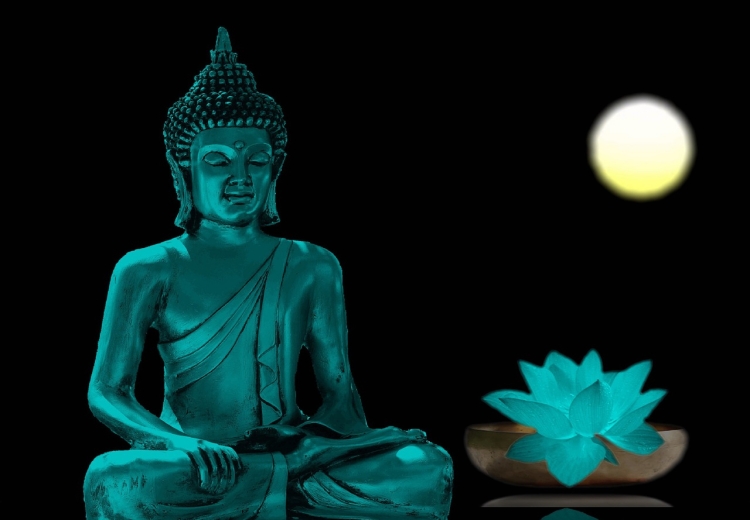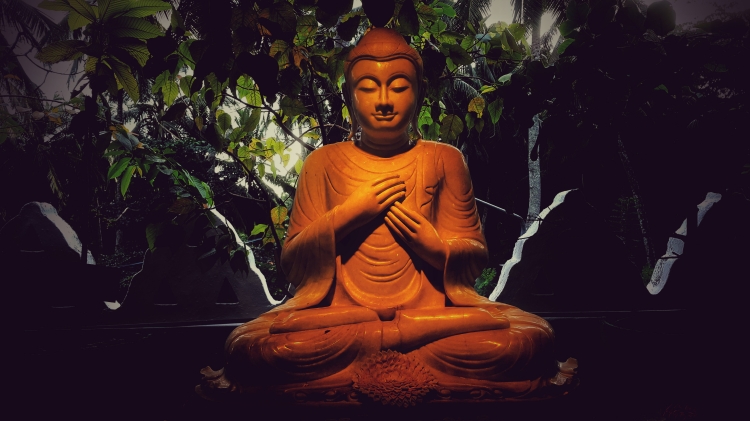I’m a bad Buddhist.
I lead with that statement when describing my spiritual practice because claiming Buddhism as one’s spiritual path often leads to the inevitable questions (or jokes) about enlightenment or the assumption that I have an outsized well of patience and wisdom. Neither of these things are true about me.
I am not enlightened, and I am cranky, impatient, and deeply flawed. In other words, I’m human.
I grew up holding myself to impossible standards, and my perfectionism made it impossible for me to fully experience my life. Before finding Buddhism, I had long rejected my Lutheran upbringing after a brief flirt with evangelical Christianity. I wasn’t without a spiritual compass, but I diligently avoided anything having to do with God or religion. Then from 2004 to 2012, I endured twelve miscarriages. Sandwiched in there was a cross-country move to Brackney, Pennsylvania, a small township just south of Binghamton, New York. My year-and-a-half in Brackney was spent adrift.

By claiming Buddhism as my path, I became capable of owning my imperfection and the impermanence of life. Buddhism became the way that I welcomed living as a practice, embracing what Thích Nhất Hạnh calls “true practice.” Finding my true practice allowed me to hold on to a part of myself during the darkest moments of my life. It allowed me to love my good and bad parts simultaneously and with compassion. As Nhất Hạnh remarks, true practice is a way to “cultivate freedom–freedom from thinking about the past or worrying about the future–aliveness, joy, and compassion.”
I often say that I’m a hedge witch. This also is true about me. Deeply depressed and profoundly disconnected from the landscape of my heart, I was lost without the soil I knew, the seasons that pulled my blood, and the plants I could recognize by scent alone. Everything was different, and if a hedge witch is connected to the land, I was a witch without a home. My depression was consuming.
Eventually, I found my way to the Self-Discovery Wellness Arts Center in Montrose, Pennsylvania. I went to find direction, to heal what had hollowed me out–the lost pregnancies, the move. Mostly, I wanted to learn how to meditate, something that I could not do.
My meditation, in hindsight, had been placing my hands in the soil and communing with the heartbeat of the land, but that was gone. My mind was disordered by grief and a sense of resentment the size of a mountain. I would see mothers half-attending their children and want to beat these women for their casual disregard of their offspring. I was inconsolable, and my brain had grown rotten with regret and sadness. I needed a new path.
I studied meditation with Anna D’Andrea (anantamayi). She was a severe and difficult teacher who insisted that I focus and learn to connect my breath to my process of clearing my mind.
“Let the thoughts flow through your mind. Don’t touch them,” she would instruct me when she sensed I was caught in a trap of regret or dissonance.
Anna had studied at the Himalyan Institute and had been meditating since the 1980s. She once described sitting with her infant daughter in her lap, the two of them matching their breaths. Her daughter was the most spiritually centered teenager I had ever met–serene and confident, kind and boundaried in ways I longed to be.
I was learning Vishoka meditation and striving to attain a state of inner focus and joy, regardless of the circumstances in my life. The process was rigorous, from learning correct posture to correct diaphragmatic breathing. We spent many hours in focused meditative practice, Anna at times instructing me and at times meditating with me. Focus and discipline were difficult for me–more difficult than anything I had ever tried before. Clearing my mind and letting the thoughts flow through me instead of endlessly ruminating over my regrets and grief felt almost impossible.
When I wasn’t studying with Anna, I was reading books about Buddhism, including Steve Hagen’s Buddhism Is Not What You Think: Finding Freedom Beyond Beliefs and Pema Chödrön’s The Places That Scare You and When Things Fall Apart. These were touchstones as I endured my pregnancy losses and battled the depression that threatened to consume me.
But although Chödrön’s brand of Tibetan Buddhism spoke to me in that moment, I found myself more drawn to Nhất Hạnh’s teachings that are centered in Vietnamese Zen Buddhism. The idea of moments of enlightenment found in mindful living felt far more attainable to me than the search for ultimate enlightenment. Furthermore, Thiền Buddhism offers a unified and welcoming version of Buddhism, that links core Buddhist practices with social action.

Image of Martin Luther King Jr. and Thich Nhat Hanh circa 1966 discussing the Vietnam War (source: Wildman Meditation website). Some time after this meeting, King nominated Nhat Hanh for the Nobel Peace Prize, saying, "I do not personally know of anyone more worthy of this prize than this gentle monk from Vietnam. He is an Apostle of Peace and Nonviolence. His ideas for peace, if applied, would build a monument to ecumenism, to world brotherhood, to humanity." (Quote Source: Charter for Compassion)
I was not a good enough Buddhist to attain enlightenment, but I was stubborn enough to be counted upon to practice my way to moments of enlightenment. I could commit to observant repetition of activities in everyday life. Nhất Hạnh has said that “the present moment is filled with joy and happiness–if you are attentive, you will see it.” This was a spiritual practice that fit for me during my time in Pennsylvania and that sustained me through another cross-country move to Knoxville, Tennessee, in 2010.
Then, in 2011, I had an accident. Not long after moving to Knoxville, I fell off my horse onto my head and suffered a traumatic brain injury. In my horse’s spook and bolt, the world was revealed as big, empty, and remorseless. Every daily act that I had taken for granted as effortless became a nearly insurmountable problem.
My depression, probably postpartum in origin and clinical in practice, instantly disappeared. Point of fact, I was rendered too stupid to be depressed. I had to relearn many things–reading, words, math, personal care, and driving. I remember re-learning how to brush my teeth, a task that felt impossible and nearly unattainable in the early post-accident days.
The first few years were frightening and bewildering. I was like a child turned loose in a world that expected me to know the rules that I no longer understood. But, what I could still do was meditate, and I could find solace in the rhythm of my day-to-day life. In some ways, I was forced to be mindful because everyday activities were puzzles to be solved, cryptic mysteries that had solutions I could no longer foresee.

When I was young, I prayed for deliverance from suffering, but now I know that suffering is the human condition. Instead, I pray for the serenity to accept this condition and to find the grace to love myself and others in spite of our imperfections. If you ask what I’m seeking, it’s not enlightenment. I look for moments of peace and calm, for the discernment to recognize the miracle of beauty, love, and the moments that cannot be replicated.
I have come to embrace the goodness in everyday tasks: turning the red clay soil in my East Tennessee garden, cooking my vegetable harvest with my husband, tracing the curve of my adopted son’s cheek as he leans in to read a book with me. Buddhist practice has allowed me to see those moments and to appreciate them in a way that wasn’t possible for me in my earlier life.
For me, the peace I find in Buddhism never ceases to surprise me. Miracles aren’t found in angelic acts and outsized sacrifices. The miracle is in my child’s smile, in the bird chatter in the mother tree in our backyard, in my best friend’s phone call. The world is alive with miracles if we attenuate to them. Every breath is a miracle if you really think about it.
In finding compassion for my own post-accident disabilities and struggles, I was able to find meaning in a spiritual practice that previously would have been impossible for me. I still struggle to meditate, and I’ve only recently added prayer to my spiritual life after reading Nhất Hạnh’s book on the matter, but these struggles are impermanent. The only work worth doing, as it turns out, is the work of presence and mindfulness.
Even with all of my flaws, I am a better teacher, mother, wife, friend, and writer now, and I credit Buddhism with that transformation. Without it, I don’t know if I could have regained as much of myself as I did post-accident. I don’t know if I could have rebuilt my life, one faltering step at a time.
In that way, Buddhism saved my life twice–once before my accident and again after my life was wiped away and remade. I am a bad Buddhist, but as Nhất Hạnh says, “I have arrived, I am home . . . I don’t want to run anymore. I’ve been running all my life, and I’ve arrived nowhere . . . my destination is the here and now, the only time and place where true life is possible.”

**Featured Image by Lahiru Supunchandra on Unsplash



Hmmm. This is really interesting.